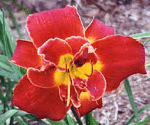AMARYLLIS
Amaryllis, plants of regal bearing and exotic flowers are unsurpassed as window gardening material. Within the layers of each brown bulb is locked the key to real garden magic. The unusual beauty and ease of culture of the new hybrids has greatly increased the popularity of amaryllis. A good amaryllis bulb will reward you with huge bouquets of sparkling fresh flowers borne on sturdy flower stems. The distinguishing marks of these choice Dutch hybrid amaryllis-finely textured overlapping petals and an abundance of flaring "pansy-faced" flowers are charactersitic of our anaryllis bulbs.
Individual flowers, in a wide array of pure or blended colors, measure up to 8 and even 10 inches across face. And it is not unusual for a single bulb to produce 4 to 8 oif these big beauties in colors to please even the most discriminating of gardeners. Glistening white, salmon, rose, light, bright or dark red, rich golden-flecked orange, color contrasts or blends, brilliant or subdued striped on a white background will lend a splash of just right ccolor to any indoor garden.
After potting, water the soil thoroughly with warm water. If you want to bring on an early flower crop, place the potted bulb in a warm 70 - 75 degrees Ferenheit room; delay flowering by setting it in a cool dark room. bulbs in warm rooms need to be watered at least once a week, in cooler spots they will not need such frequent watering.
As soon as leaves or flower buds show, place the amaryllis in an east, southeast or south window or flourescent-lighted spot. Water either from top or bottom but do a thorough job. Then don't water again until the topsoil feels dry to touch. Winin about 60 days you will have a floral crop that will be the envy of all your gardening friends. After the buds unfold, flowers will last longer if you move the plant out of the direct sun.
In early to mid-September outer leaves often begin yellowing, an indication that the amaryllis need a rest. Cut all leaves to within an inch of the neck of the bulb. Repot garden planted ones; scrape away old topsoil on the potted ones and replace with about an inch of fresh soil.
Store amaryllis in a cool spot, 50-55 degrees Ferenheit. Moisten them slightly about once a month to keep them from shriveling. In late December or early Janaury when they show signs of growth, water them and bring into warmth and lisght. Here they will bring to your winter window garden another mass of gorgeous color.
---Peggy Schulz
